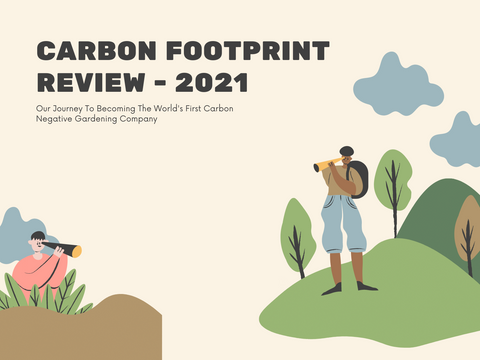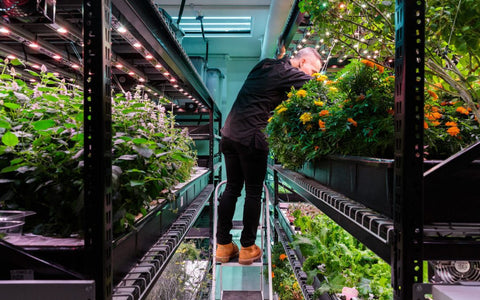Why Count Carbon?
Manufacturing ‘stuff’ is messy. But when that mess is created a long way away, and the mess takes the form of invisible gases that waft into the atmosphere, the 'mess' can be easy to ignore. The truth is, however, that no set of actions you take today will have a bigger impact on our planet than the products you consume and the food you eat.
Events like bush fires, drought, flooding, and rising sea levels remind us that the environmental consequences of our behavior are not something we can ignore indefinitely.
The purpose of this report is to share with you the progress that Urban Leaf has made since Earth Day (April 22, 2021), when we announced our plans to become the World’s First Carbon Negative Gardening Company. This blog provides an overview and explanation of how we have estimated our carbon dioxide equivalent emissions of 40.2 tonnes and its breakdown across Scope 1, 2, and 3 emissions.
How Does It Work?
Every item we interact with daily requires the consumption of energy to produce and transport it. The chair you’re sitting on, the phone you’re scrolling on, the footpath you walked on earlier, and your last meal. None of these things would exist were it not for the energy that went into producing them, and the generation of that energy created environmental emissions.
These emissions are now altering the climate of our planet. Climate-altering greenhouse gases come in many forms, but to standardize their measurement and reporting, we tend to talk about them in terms of their carbon dioxide equivalent (CO2eq).
Since our Earth Day 2021 post on the topic, we have built a detailed carbon accounting model for our entire business that:
- Allows us to better understand the size and shape of our own footprint
- Helps us identify meaningful reduction opportunities for the future
The table below offers an example of the calculations we have performed for every single product we sell. This small example is for our popular Microgreens Growing Kit.
| Material | Weight of Material per Unit Sold (kg) | CO2eq (kg per kg) | CO2eq (kg) |
|---|---|---|---|
| Printed Paper Instructions | 0.008 | 2.7 | 0.022 |
| Printed Paper Envelope (seed packets) | 0.008 | 2.7 | 0.022 |
| Printed paperboard belly band | 0.03 | 2.229 | 0.067 |
| Cardboard | 0.093 | 2.229 | 0.207 |
| PET | 0.105 | 1.996 | 0.210 |
| LDPE Bag | 0.011 | 1.597 | 0.018 |
| Jute | 0.063 | 0.566 | 0.036 |
| Total | 0.580 |
This table shows the seven different types of materials required to make each of our kits, the weights of each material we require, and the carbon emissions intensity of that material. By multiplying material weights (first column) by carbon intensities (second), we get the total embodied carbon for each component (third).
We estimate that every Urban Leaf Microgreens Kit has an embodied carbon footprint of 0.58 kg CO2eq. The transport of these materials from the various raw materials suppliers to our warehouse, the assembly of the raw materials into a ‘kit’, and eventually the shipping of this product to an end customer all create additional emissions. These have also been accounted for in our modeling.
The approach we chose for developing our carbon accounting model is the Greenhouse Gas Protocol, an internationally accepted set of standards for measuring and reporting greenhouse gas emissions. The Greenhouse Gas Protocol divides emissions activity into three categories, as per the United States’ EPA greenhouse gas inventory guidance.
Scope 1, 2 and 3 Breakdown
Scope 1 and 2 are small, and simple to calculate
Scope 1 and 2 are the result of direct operational activities.
- Scope 1 encompasses company facilities and owned vehicles. Because Urban Leaf’s employees all work from home (and have done so since before the pandemic), our scope 1 emissions are zero.
- Scope 2 is only slightly higher for us but includes the purchased energy used in our facilities. For this scope, we consider our home offices as company facilities during the workday. The electricity used for computers, lighting, growing equipment, and testing is all accounted for as company impact.

Because of our low operational impact from owned facilities, almost all of our emissions are generated in the process of manufacturing and distributing the goods that we sell (Scope 3). This is the case for almost all consumer goods companies, although many companies conveniently ignore their Scope 3 emissions for the purpose of setting reduction targets and talking about things like 'Net Zero'.
In addition to supplying an emissions tally to inform our carbon offset purchases, carbon accounting also provides us with a ‘heat map’ for where to focus source reduction efforts. Source reductions are the most effective method for impact reduction, but opportunities for source reduction are limited when thoughtful and waste-saving design practices are followed in the first place (which is how we have aspired to operate since our inception).
Scope 3 Is What Matters The Most, So Why Do Others Ignore It?
We believe there are several reasons why most consumer products businesses will ignore their Scope 3 emissions and focus only on (the smaller) Scope 1 and 2 emissions in their reporting and reduction targets:
- It’s easier. Scope 1 and 2 are typically what people produce from their offices. Headcount, computer wattage, and hours worked per day are the main drivers of this. Assessing Scope 3 emissions, however, requires an understanding of raw material procurement, logistics, weights, and quantities of every single product a company produces.
- Ownership. Although companies like Urban Leaf produce products, we are not the end owners of these products. Consumers buy our products; therefore, they are technically the ultimate 'owners' of the emissions generated in the products’ manufacture. Most businesses don’t want to remind their consumers that it is their own consumption of products which is responsible for the lion's share of the emissions being generated. After all, if consumers stopped buying, the businesses would cease to be in business.
While our decision to include Scope 3 emissions in our carbon accounting model may be unusual in the corporate world, we believe it is necessary if humanity is to effect the type of change that our environment demands.
Summary Of Our Carbon Accounting Model
In 2021, we estimated our Scope 1, 2, and 3 emissions to be a total of 40.2 metric tons. This is a 14% increase from 2020, and as you can see, the largest parts of our carbon footprint came from the materials we consume to make products, the inbound freight of those materials, and the downstream delivery of those materials (i.e., shipping them from us to you).
| Scope/Category | 2020 | 2021 |
|---|---|---|
| Scope 1 | 0 | 0 |
| Scope 2 | 390 | 444 |
| Scope 3 | 34,844 | 39,717 |
| 1 - Purchased Goods and Services | 21,153 | 28,556 |
| 2 - Capital Goods | 2 | 0 |
| 4 - Upstream Transportation and Distribution | 9,320 | 5,501 |
| 5 - Waste Generated in Operations | 84 | 84 |
| 9 - Downstream Transportation and Distribution | 4,241 | 5,563 |
| 11 - Use of Sold Products | 44 | 13 |
| Total CO2e emissions (kg) | 35,235 | 40,161 |
Where To From Here?
Equipped with an assessment of the magnitude of our own environmental footprint, our next step was to go about reducing it. As discussed in our Earth Day 2021 post, we have committed to a ‘Net Zero’ position for 2021, and in 2022 we will be ‘Net Negative'.
To learn more about how we have achieved Net Zero for 2021, we refer you to our accompanying article titled ‘Urban Leaf’s Path To Net Zero for 2021’.









Very impressive goals and accomplishments!